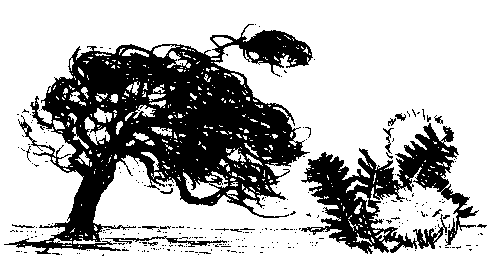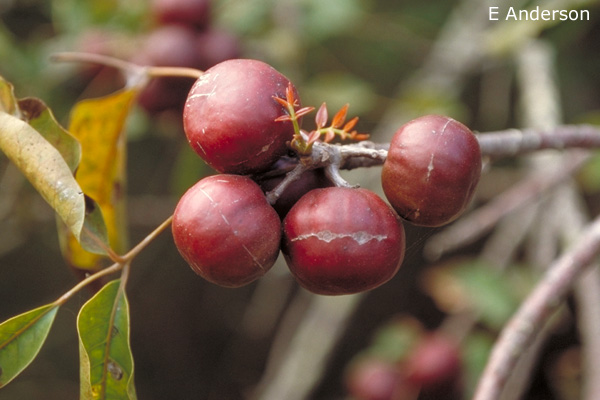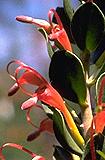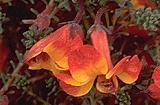|
[Front Page] [Features] [Departments] [Society Home] [Subscribe]

Short Cuts
Readers are invited to submit short items of interest about Australian plants to be included here. If submitting non-original material (eg newspaper or magazine cuttings), please also advise if the author has given permission to republish and, if not, please provide a contact address so that permission can be sought.
Short Cuts in this issue:
 Wheels on Fire! Wheels on Fire!
- The much-loved, hardy and spectacular firewheel tree.
 Coastal Update Coastal Update
- Battling the coastal gales on Victoria's south coast
 Burdekin Plum - Pleiogynium timorense Burdekin Plum - Pleiogynium timorense
- This attractive and versatile tree may have a big future
 Winter Colour Winter Colour
- Banksias, grevilleas and many others provide a riot of colour in the colder months
 Things Are Not Always As They Appear Things Are Not Always As They Appear
- A few simple guidelines for growing Lechenaultia

Wheels on Fire!
Despite its tropical and sub-tropical origin, the spectacular Firewheel Tree has proved to be adaptable to a wide range of soils and climates. Norm McCarthy thinks it's fantastic!
The firewheel tree, Stenocarpus sinuatus, can be found in rainforest habitats ranging from north Queensland to the Belligen River in northern New South Wales, and in the ranges adjacent to these habitats. The tree is recognised as one of Australia's most beautiful flowering trees.
 |
The firewheel tree, Stenocarpus sinuatus is a spectacular tree with glossy foliage and brilliant red/orange flower clusters.
Select the thumbnail image or highlighted name for a higher resolution image (43k).
|
Stenocarpus sinuatus develops into a tall erect tree to 30 metres in its natural setting, but it is usually only 10 metres tall x 5 metres wide in cultivation.
The foliage is quite dense and attractive. Individual leaves are normally bright dark green and display a glossy upper surface with the under-surface a pale green. The leaf blade can be deeply lobed (pinnasect) or entire with wavy margins (sinuate) and may be 35cm long. Like may proteaceous plants leaves may change their shape at will.
Flowering may occur anytime from 10 to 15 years of age and can be sporadic until older. The flowers are terminal or nearly so, bright red and symmetrical like the spokes of a wheel. Characteristically they occur on old wood in umbels of 6 to 20. Individual flowers may be up to 10cm in diameter. Normal flowering takes place from summer to autumn though odd flowers may occur when induced by high rainfall and humidity. This tree produces copious quantities of viable winged seed contained in multiple pods about 7cm long.
Stenocarpus responds well to high rainfall, deep soils and high humidity. Given these conditions the species tends to flower well. In its natural setting it enjoys an annual rainfall of from 1000mm to 4000mm. When in full flower the tree is a glory to behold.
Generally propagated from seed, Stenocarpus is slow growing initially and should be protected from frost in its early stages. However growth accelerates with age. Fresh seed is essential for good germination. Propagation from mature cuttings or grafting onto suitable rootstock should promote earlier flowering potential.
The firewheel tree is richly ornamental and is an asset to any garden in or out of bloom. It is most adaptable and trouble free with no known problems or predators.
From the January 2000 issue of "Native Plants for New South Wales", newsletter of the Australian Plants Society (NSW)
[ Return to Index ]

Coastal Update
Trevor Blake gives an update on his coastal gardening article from the March 1999 issue of Australian Plants online
Last year I rambled on about coastal exposure and salt burning of vegetation. Well I thought an update on the situation experienced over the last 12 months worth recording.
The 5 huge Monterey Cypress that deflected a lot of onshore winds were removed from the foreshore and so too were others around the community. It's strange, but visually they are not missed. In fact, it looks right that they are gone. Our next door neighbours took the bit between their teeth and removed 17 mixed golden and Monterey Cypress, some enormous. Our view of the ocean which is only 50 metres away increased from 10 to 180 degrees instantly.
 
Almost from the moment the trees were removed the easterly winds started and there has been one storm after another for over 6 months with little rain. The easterlies on Victoria's west coast are onshore, churning winds that drive fine salt spray over the hills which come right down to the sea. The result has been that all along the Otway coast the Eucalyptus viminalis, which are dwarfed and stunted have been burnt severely. In fact it looks as though fire has scorched them. The eucalypts that were in ours and our neighbour's gardens that have been suddenly exposed, have been burnt so severely I doubt if any will survive. Sure the epicormic buds will shoot but a couple of good easterlies on these tender shoots will finish them off, particularly if there is no cleansing rains.
Its interesting to see some of the damage to vegetation that has occurred around here. Acacia sophorae, right along the plantations on the foreshore have been dramatically burnt. Acacia verticillata, has suffered too. Mature bushes of Agonis flexuosa have been burnt back by 3 metres or more and small shrubs to 1 metre have been totally destroyed. Callistemon citrinus and C.rugosus have lost all new growth. Melaleuca nesophylla has been cut back 1 metre out of its 3 metre height. Allocasuarina littoralis has been similarly attacked. I thought that the several Eucalyptus cornuta were in fairly protected sites but these 3 year olds look fried. Leptospermum continentale, a local, has been affected. We have Banksia integrifolia in on an exposed site on the foreshore and it has lost 50% of its leaves. Corymbia ficifolia which would be at least 40 years old has been decimated. Hakea oleifolia has lost 50% of its foliage too and this has been really resistant to salt damage.
So much for the misery side of coastal gardening 50 metres from the water's edge. There are plenty of successes. About 7-8 years ago we had planted a garden bed below our neighbour's massive cypress trees. You guessed it, they struggled, in fact, the growth of most species could be measured in millimetres
each year - not exactly what we had hoped, still we kidded ourselves they were a vast improvement on aggies, periwinkle and roses that aging "rellies" loved.
Spurred on by the physical satisfaction of demolishing these weeds we took on an adjoining area, similarly covered but with cotoneaster, hebe and coprosma - this clearing took place only a couple of years ago. Into this area we planted many Poa poiformis, Correa alba, C.nummulariifolia, C.glabra, Leucophyta brownii, Scaevola aemula, S.albida "Kawarra Pink", Regelia velutina, Myoporum parvifolium, Orthrosanthus multiflorus, Chrysocephalum apiculatum, Goodenia ovata (prostrate) and many others. The poas grew well and provided protection and this lower section began to thrive. The cypress were removed and the growth over the last 6 months has been impressive. The plants that had been struggling had moisture and sunlight and we watched them grow before our eyes.
The mulch that had been applied has made a magnificent seedbed with Eucalyptus vimimalis, Acacia melanoxylon and Westringea fruticosa coming up everywhere. Birds roosted in the cypress and their droppings contained seed of the coastal Leucopogon parviflorus with the result that hundreds germinated, so too has Myoporum insulare, Tetragonia implexicoma, Enchylaena tomentosa and Danthonia sp. - all indigenous species. Transplanting of many of these over-abundant plants is taking place and many of those decimated by the easterlies are being replaced.
Most plantings however, will be of indigenous species but I guess we will have to persevere with the coastal Eucalyptus viminalis, even if it's only to provide some food for our regular koala visitors. Incidentally, we observed a koala walk up the steps of a verandah, view the tucker potential and proceed to the lushest tree with all haste....at least that's our interpretation! The rufous bristle bird is a regular companion and it too must have plenty of low protection.
The Goodenia ovata will be propagated and spread around exposed areas that were once covered with periwinkle. This really is an excellent groundcover, layering if left alone and flowering during summer. Scaevola albida "Kawarra Pink" hardly stops flowering, provides dense groundcover and layers and seeds a little.
No doubt there will be a sorting out of species over the next couple of years so we will watch with interest.
From the September 1999 issue of "Growing Australian", the newsletter of the Australian Plants Society (Victoria)
[ Return to Index ]

Burdekin Plum - Pleiogynium timorense
Joseph Banks complained that the fruits of Burdekin plum were "so full of a large stone that eating them was but an unprofitable business". But big things may yet be in store for this North Queensland plant, as Greg Calvert reports.
Burdekin plum (Pleiogynium timorense) can be a large and shapely tree to 20 metres or more under good conditions, or a stunted, almost bonsai shrub under harsher conditions.
Formerly known as Pleiogynium solanderi, the Burdekin plum has a dark grey trunk and often glossy, compound leaves. This tree can be found in vine thickets, gallery rainforest and along creek lines in tropical Queensland and Papua New Guinea.
Even within a small area, Burdekin plum can be extremely variable in appearance and the fruit vary considerably in size, colour and taste. In the wild, fruiting occurs in the winter months and seeds are apparently dispersed by flying foxes and wallabies. As with its close relative, the Mango, the flowers are small and insignificant.
Seeds germinate readily if they have been soaked in a bucket of water for 24 hours prior to planting. Burdekin plum can be a little slow in the first couple of years, but soon puts on some fairly rapid growth. Eight years seems to be the minimum age for fruiting. However, grafting may produce some interesting effects. Burdekin plums are widely grown in Townsville gardens and revegetation projects.
The fruit were popular with Aborigines, explorers and settlers, but seem to have fallen into disuse sometime after World War 2. They are fortunately experiencing a revival.
 |
The fruits of Burdekin plum were collected by Joseph Banks during James Cook's exploration of the east coast of Australia.
Select the thumbnail image or highlighted name for a higher resolution image (20k). Photo: Eric Anderson
|
The large, black, globular or pumpkin-shaped fruit vary in taste. Those that have red-purple flesh are quite tart, those with a pale greenish-white flesh are milder but less tasty. Some fruit are half red - half white and these are delicious! This variety occurs naturally around Townsville.
The riper the fruit, the less unpleasant the drying effect of eating the fruit. In the centre is a large pitted stone which usually fills 70-80% of the total fruit. They do not ripen on the tree, but must be stored, either buried in sand or kept in paper bags in a dark spot for a few days.
They can either be eaten raw, cooked into jam or jelly, used to flavour meat, or to make wine. A ripe fruit is mostly water (73%), but has moderate levels of energy, fat, vitamin C and is high in fibre and most minerals. Analysis has shown that, like tree shape and fruit colour, the nutritional content is extremely variable between trees.
Experimental plantations are being established and there seems to be enormous potential for selecting superior varieties and grafting. The timber is regarded as one of the best native timbers by wood turners, who prefer to salvage fallen trees rather than cut down such a useful tree!
Look for the old seeds underneath the tree. They look like little UFOs with portholes in the side.
Burdekin plum is in the family Anacardiaceae, along with Mangoes and Cashew Nuts.
From "The Native Gardener", SGAP Townsville Newsletter, August 1997
[ Return to Index ]

Winter Colour
There's lots of colourful plants that will brighten up the coldest, greyest, winter's day. Chris Larkin has lots of favourites to share......
Any time between April and November is good in the garden, but if I had to pick a favourite season it would definitely be winter. I like the softer light of winter, not the grey days which can come at any time of the year but the more watery, winter sun as it lights up the different foliages and flowers.
A great number of plants are in flower here in winter - Hakea, Correa, Thryptomene, Grevillea, Brachysema, Hibbertia, wattles, Banksia, Brachyscome, Adenanthos, Philotheca - just to give you an idea. Some of the plants that are in flower are quite surprising. Despite the Encyclopaedia* stating that Chamelaucium ciliatum flowers in September - November, it has always flowered at this time of year and for several months. It is a particularly beautiful stiff blue-grey foliaged plant with masses of small white flowers. At a glance it doesn't look at all like the more commonly grown Chamelaucium uncinatum (Geraldton Wax) and I've often thought it would look quite fine in an exotic garden. Another plant that is meant to flower later in the year is Casuarina nana. I have a female plant with a particularly fine structure that is always massed with flowers along its branches in winter. One of my real delights is to see the blood red flowers glow with the sun behind the tree.
 |
Banksia "Birthday Candles" puts on a great display over many weeks during winter
Select the thumbnail image or highlighted name for a higher resolution image (31k).Photo: Australian Plants Society
|
Winter is the time of year when my favourite dwarf banksia - "Birthday Candles" - puts on its wonderful display. It is a very small shrub (mine would not even be 0.5m) but it has a lovely growth habit and it displays its flowers extremely well as they basically sit above the foliage. The original plant has been such a good performer that I've planted three more of them in the newer section of the garden. This is a little massed planting so it may be quite a feature.
Although I am not lucky with a wide variety of eremophilas, I do have a few and they are at their best in late autumn through winter. Several of them are forms of Eremophila glabra - from prostrate to bushy - with red, yellow and orange flowers. It has been a real pleasure to see the colour combination of the red flowering Correa 'Mannii' coming up through, and mixing with, the yellow flowering E.glabra. If I can succeed in getting an orange flowering E.glabra to thrive in the same vicinity then the picture may become more interesting still.
 |
 |
Two winter-flowering members of the protea family; Adenanthos obovata (left) and Grevillea tenuiloba (right).
Select the thumbnail image or highlighted name for a higher resolution image (30k and 42k).
|
Adenanthos obovatus is definitely a plant that people should consider for winter colour. There is no doubt that at this time of year it is at its best with lots of scarlet tubular flowers along stems which radiate out and up from the plant's base. This whole plant is very neat with attractive light green foliage and, to be honest, my plant never seems to be without a flower.
There are lots of grevilleas out at this time of year. In my garden they have been coming out gradually over the season so there is always something new to excite the senses. Much to several peoples amazement I am successfully growing G.tenuiloba ungrafted. It has been planted on an embankment so that it cascades down and over a very large rock right beside a pathway - a perfect setting to display the wonderful and profuse orange toothbrush flowers. Not far from this plant is a group of three G.banksii. The contrast of the large, deep red velvety flowers with the blue foliage of the plant is truly stunning.
There is no doubt that there is a lot of excitement in gardening, especially with Australian plants. A range of Australian plants are still not commonly grown, so there is the excitement of seeing plants grow to maturity and seeing them flower. There is also the excitement of seeing how plants combine in the garden to produce what you hope will be a pleasing effect. It is good that many plants flower twice a year because of the sense of anticipation and delight at seeing those flowers yet again. I do, however, grow several plants that flower all year round and they have an important role in providing constant colour and floral interest while the plants around them are coming in and then going out of season.
From the November 1999 issue of the newsletter of the Garden Design Study Group
[ Return to Index ]

Things Are Not Always As They Appear
Conventional wisdom says that Lechenaultia is a difficult genus in cultivation. Bill Cox has other ideas......
Few things are more spectacular than a well grown Lechenaultia, yet they are regarded as difficult to grow by the average gardener.
Lechenaultia formosa, which is red and of prostrate habit, is so soft and dainty that one is scarcely game to touch it. But what a special eye-catching plant for a hanging basket, tub or garden. The sort of plant that can lower the jaw of the most hardened cynic.
For those of us who have not seen the plant in its home turf in Western Australia, it is indeed hard to understand how to treat this gem of the West.
Acquired hands-on experience has taught me a few things about this plant. I reckon I've killed as many lechenaultias as the next person while learning these few things, and they (the plants), have all died from excessive kindness!
Firstly: Things are rarely as complicated as they first appear. A basic feel for nature, a need to understand, an ability to bounce back from disappointments, and the love of that grit-under-the-fingernails feeling, are all important when dealing with such things.
A high percentage strike rate can be expected from Lechenaultia cuttings if taken when the plant is healthy and actively growing. Old wood, newish wood and tip cuttings can be used, it depends on the sophistication or lack of sophistication, of one's propagation techniques. But lets keep it simple. For example, a 30 litre clear plastic storage container with lid, works very well when combined with just the right amount of light and warmth. The lid can be propped open at one end to allow for ventilation as required.
 |
 |
Lechenaultia formosa is available in a range of colours. the red, prostrate form (left) and a slightly more upright red and yellow form (right).
Select the thumbnail image or plant names for higher resolution images (35k and 40k).
|
A course washed sand with the addition of some composted coconut fibre (available in bricks) or if you must, peat moss, can be used in varying degrees, eg. 3 parts sand to 1 part fibre, or thereabouts will do. This can be adjusted as you learn, but basically the mix needs to be evenly moist at all times, NEVER WET. The addition of some moist course sand or fine pebble in the bottom of the box is an advantage in creating humidity, but please poke a couple of holes in the bottom of the box for drainage.
For beginners, may I suggest you try a combination of different cutting material and sand/fibre mixes in the one box. Label each batch clearly and enter all particulars in a record book for future reference, ie. plant name, type of cutting, date set, date struck, particulars of mix, and so on.
When the cuttings have formed a goodly amount of roots, pot on into small pots and place in a sheltered warm position to harden off, using a similar mix to the propagation mix, but with the addition of some good free draining potting mix and remember moist not wet. When they look healthy and actively growing, repot into hanging baskets, tubs or put into the ground.
So everything at this point is fairly normal but it is at this point that most of us make our mistakes. Forget how soft and dainty Lechenaultia formosa appears! A very open, free draining potting mix is essential, with the addition of some slow release fertiliser, for example, Australian Native Osmocote.
Place hanging baskets, tub or whatever, in a sunny, airy, even windy position and DO NOT overwater. After the plant is established, remove the saucer from the pot to insure good drainage. Don't be frightened to put one or two plants in the ground, you may find that you have to treat them as annuals under these conditions, but because they are so easy to propagate, why worry. In addition, to make the flower really red and the plant tough, every time you walk past it, call it ugly!
From the November 1999 issue of the newsletter of the Central West group of the Australian Plants Society (NSW)

[Front Page] [Features] [Departments] [Society Home] [Subscribe]
Australian Plants online - March 2000
Association of Societies for Growing Australian Plants
|